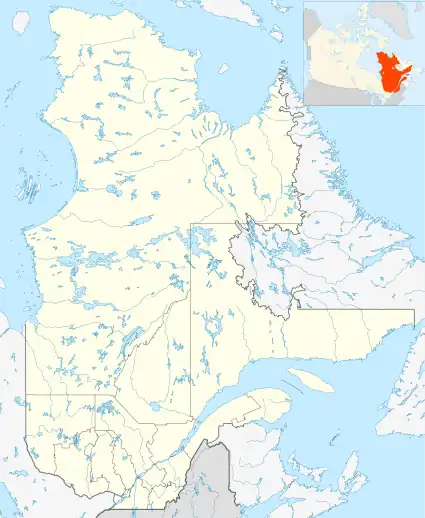Timiskaming First Nation | |
|---|---|
 | |
 Timiskaming | |
| Coordinates: 47°38′N 79°28′W / 47.633°N 79.467°W | |
| Country | Canada |
| Province | Quebec |
| Region | Abitibi-Témiscamingue |
| Regional county | None |
| Formed | 1854 |
| Government | |
| • Chief | Vicky Chief |
| • Federal riding | Abitibi—Témiscamingue |
| • Prov. riding | Rouyn-Noranda–Témiscamingue |
| Area | |
| • Total | 18.20 km2 (7.03 sq mi) |
| • Land | 18.39 km2 (7.10 sq mi) |
| Population (2021)[2] | |
| • Total | 541 |
| • Density | 29.4/km2 (76/sq mi) |
| Time zone | UTC−05:00 (EST) |
| • Summer (DST) | UTC−04:00 (EDT) |
| Postal Code | J0Z 3B0 |
| Area code | 819 |
| Website | |
Timiskaming (former official designation Timiskaming 19) is a First Nations reserve in the Abitibi-Témiscamingue region of Quebec, Canada, just north of the head of Lake Timiskaming. It belongs to the Timiskaming First Nation, an Algonquin band.[3] It is geographically within the Témiscamingue Regional County Municipality but administratively not part of it.
History
In 1853, following the proposed distribution by Commissioner of Crown Lands, John Rolph, the Governor General in Council, Charles Monck, 4th Viscount Monck, assigned the Nipissing, Algonquin, and Ottawa Indians of the Timiscaming region a reserve of 38,400 acres (15,500 ha), located along the Ottawa River, and originally known as Temiscamingue Reserve. But piece-by-piece, the reserve was reduced in size when the Indians ceded lots back to the government in 1897, 1898, every year from 1905 to 1917, 1939, 1953, and 1955. But many of these surrenders are now being disputed.[4]
On October 23, 1999, the Quebec government officially recognized a name change from Timiscaming to Timiskaming.[5] On July 30, 2002, the Department of Indian Affairs recognized that the reserve's name was changed to Timiskaming.[4]
Demographics
Population
As of May 2022, the registered population of the Timiskaming First Nation is 2,519 members, of whom 648 live on the Timiskaming reserve and 1,871 live off reserve.[6]
| 2011 | |
|---|---|
| Population | 540 (6.9% from 2006) |
| Land area | 18.19 km2 (7.02 sq mi) |
| Population density | 29.7/km2 (77/sq mi) |
| Median age | 28.8 (M: 28.8, F: 28.0) |
| Private dwellings | 191 (total) |
| Median household income | $.N/A |
Language
Mother tongue:[8]
- English as first language: 87.5%
- French as first language: 8.7%
- English and French as first language: 1.9%
- Other as first language: 1.9%
Economy
The reserve's economy is tied to the adjacent town of Notre-Dame-du-Nord and mostly based on logging, farming, construction, and tourism. There are about 15 enterprises on the reserve.[3] The Timiskaming First Nation administration employs about 70 persons.
Education
There is only one school on the reserve: Kiwetin School, providing pre-Kindergarten to grade 8. It had an enrolment of 65 students in 2008-2009.[3]
See also
References
- ↑ Reserve/Settlement/Village Detail
- ↑ "Profile table, Census Profile, 2021 Census of Population - Timiskaming, Indian reserve (IRI) [Census subdivision], Quebec". 9 February 2022.
- 1 2 3 "Timiskaming First Nation". Crown–Indigenous Relations and Northern Affairs Canada. Government of Canada. Retrieved 2012-10-26.
- 1 2 Natural Resources Canada - Legal Surveys Division, Historical Review - Timiskaming land title history Archived 2011-07-06 at the Wayback Machine
- ↑ "Archived copy" (PDF). stat.gouv.qc.ca. Archived from the original (PDF) on 30 December 2006. Retrieved 30 June 2022.
{{cite web}}: CS1 maint: archived copy as title (link) - ↑ "Indigenous communities in Quebec". 15 October 2021.
- 1 2 "Electronic Area Profiles". Canada 1996 Census. Statistics Canada. Retrieved 2013-05-11.
- 1 2 "2011 Community Profiles". 2011 Canadian Census. Statistics Canada. March 21, 2019. Retrieved 2014-01-29.
- ↑ "2006 Community Profiles". 2006 Canadian Census. Statistics Canada. August 20, 2019.
- ↑ "2001 Community Profiles". 2001 Canadian Census. Statistics Canada. July 18, 2021.